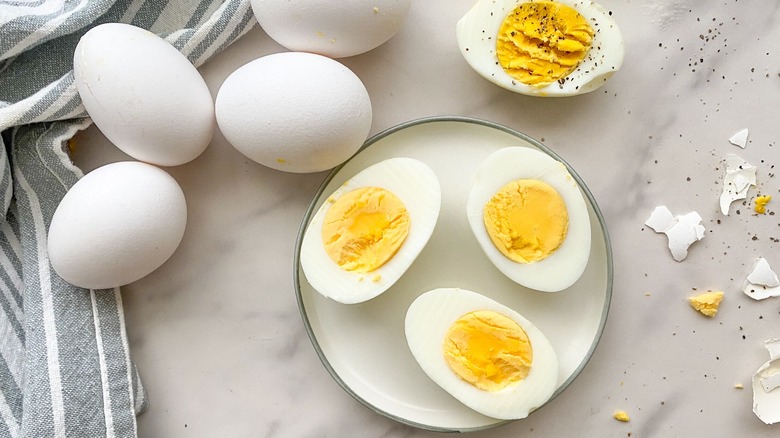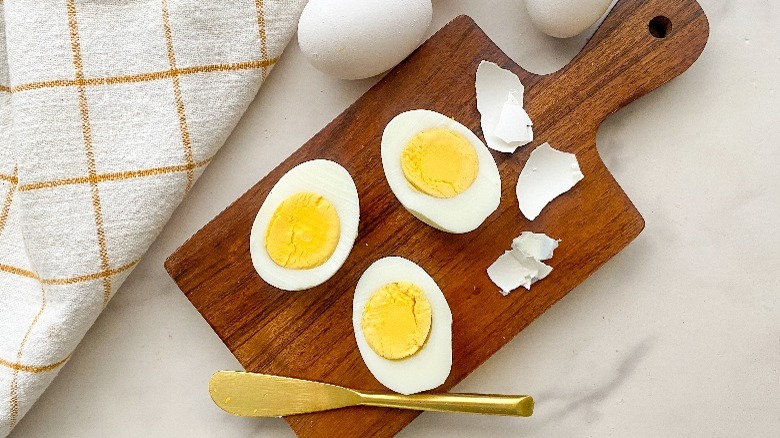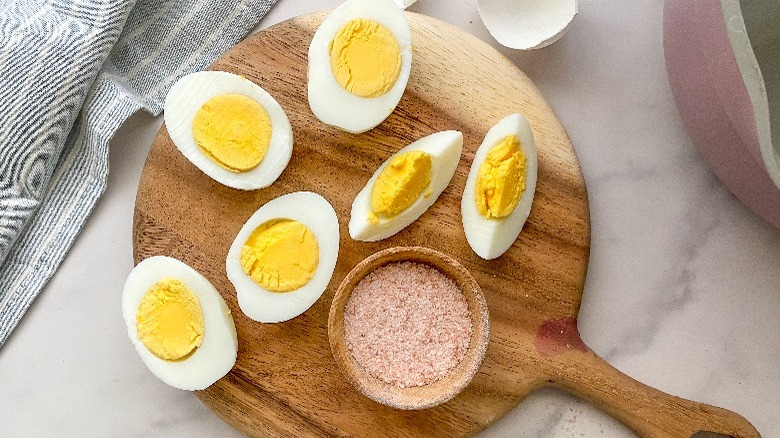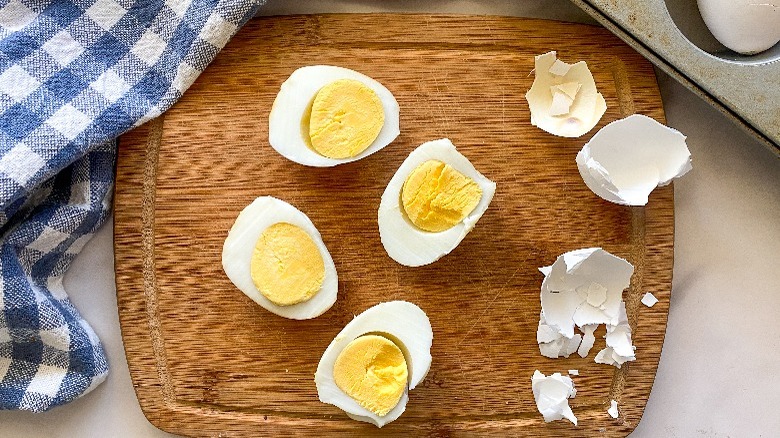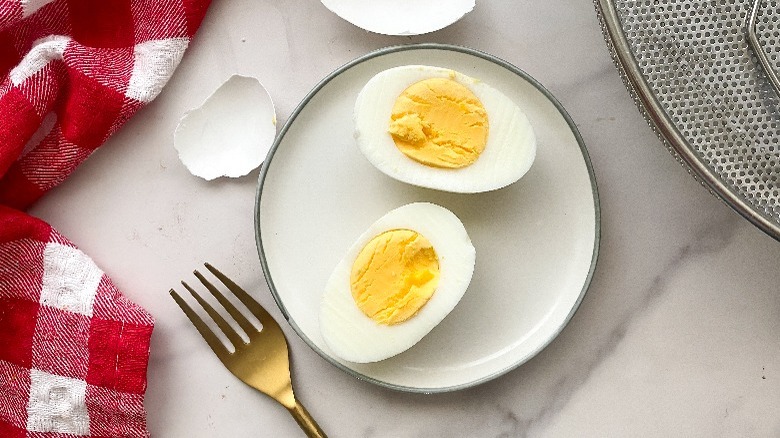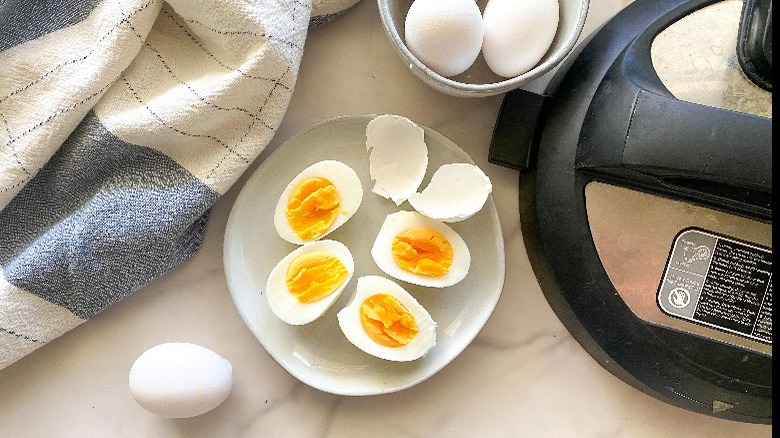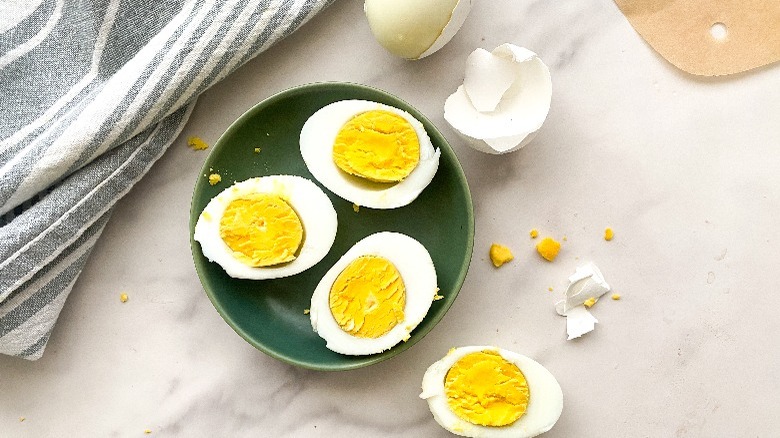We Tried (Almost) Every Way To Cook A Hard-Boiled Egg
Eggs are a staple in many households. In fact, we bet there are at least half a dozen in your fridge right now (and if not yours, then certainly your neighbor's). They are often referred to as nature's perfect food and are loved either scrambled, poached, fried, soft-boiled, or hard-boiled, to name but a few. If you have ever made hard-boiled eggs, then you know that there are many methods, and you also know the results can be a bit quirky. Sometimes they're hard to peel, sometimes they aren't cooked enough, sometimes they're overcooked, they can crack while cooking, and there can be a visible ring around the yolk. Is there a fool-proof method? Well, we just may have a favorite.
Read on to discover 6 ways to make a hard-boiled egg. In all of the methods we will be using white, large eggs and pulling them straight from the fridge before cooking. Let's get to it!
Making hard-boiled eggs by boiling and steeping
Probably the most common way to hard-boil eggs is to place them in a pot, cover with water, bring the water to a boil, then remove the pot from heat and let it sit for 20 minutes. If you're using eggs on the smaller side, 15 minutes should be perfect, and if they are jumbo eggs, you're going to need to wait about 25 minutes. After the wait time is up, put them in a colander and rinse them under cold water for a few minutes until they are completely cool.
This method is a tried-and-true procedure and provided hard boiled eggs that peeled easily and had a smooth yolk that wasn't crumbly. The downside to this method is the strict nature of timing. You must be front and center in your kitchen the entire time the pot's over heat, so you're able to quickly remove the pan once it's boiling and get them rinsing at the proper moment after they've sat. If you have other things you need to be cooking at the same time, it's easy to get distracted, and you could miss that critical timing. The nice thing is that the equipment is minimal — everyone has at least one pot, right?
Making hard-boiled eggs with already boiling water
Another common method for hard-boiling eggs is starting the boiling process without the eggs in the pot. So here, we're going to fill a pot with water and once it starts boiling, we want to lower the eggs into the pot. We'll return the pot to a boil and then lower the heat to a simmer for 20 minutes with the cover on. When the timer goes off, transfer the eggs to a large bowl of ice water to stop the eggs from cooking.
This method worked well in providing a fairly easy-to-peel egg, with just a bit of trouble separating the membrane from the shell. The yolks pulled away from the whites slightly and were a little on the crumbly side. As in the first method, this process can be a little high maintenance and keep you pinned to your kitchen without the luxury of a distraction. Equipment is minimal and clean-up is quick.
Making hard-boiled eggs in the oven
Who knew you could make hard-boiled eggs in the oven? It's actually one of the simpler methods we tried. Preheat the oven to 325 F. Place the eggs in a muffin tin and pop it into the oven for 30 minutes. When they're done, plunge them into an ice bath for 10 minutes. The eggs came out perfect and peeled easily. When eggs cooking in boiling water in a pot, you run the risk of the shells cracking against the metal surface. Here, with no boiling water to agitate the eggs,, we didn't see any cracking during cooking. The yolks were mostly smooth with a little pulling away from the white part (a great head start if making deviled eggs). This method leaves very little room for error. You heat up the oven, pop the muffin tray in and then transfer them to an ice bath. It eliminates the need for multiple steps and is very convenient if you are cooking a full dozen of eggs as a standard muffin tin gives you 12 slots. For this method you do need to own a muffin tin, but it should be able to go right back on the shelf with a quick rinse — no scrubbing needed.
Making hard-boiled eggs with a steamer
For this method, pull out your steamer and the pot it goes with. Fill the bottom pot with water and bring it to a boil. Once boiling set the steamer basket in place and add the eggs in a single layer. Lower the heat to medium high and cover the pot. Set the timer for 15 minutes, then remove the pot from heat promptly and put the eggs into an ice bath for 15 minutes. This method resulted in a few eggs getting cracked, but it also yielded the easiest to peel eggs with large sections coming off easily. There was no ring around the yolk and the yolks were smooth. If you happen to own a steamer, this is a good method if you are working with a small number of eggs.
Making hard-boil eggs in an Instant Pot
The Instant Pot is a handy tool for so many things and makes a great option for making hard-boiled eggs. Just pop in the rack that comes with the Instant Pot and add the eggs in single layer. Pour in 1 cup of water. Close the lid and make sure the nozzle is set to "sealing", select high pressure, and set the time to 5 minutes. After the cook time, let them natural release for 5 minutes. Then transfer them to an ice bath and let them cool for 5 minutes. A couple of the eggs cracked using this method, but the egg was contained within the shell, and it actually made the peeling go quick. The eggs were moist and had smooth yolks with no ring around the yolk edge. Even though the cook time is only 5 minutes, it does take time for the Instant Pot to reach pressure, which gives you ample time to work on something else without keeping a close eye on a boiling pot. The issue with the Instant Pot however is the small size, making it hard to hard-boil more than six eggs at a time.
Making hard-boiled eggs in the air fryer
Air fryers are all the rage right now and of course we can use them for making hard-boiling eggs. For this method, simply put the eggs in the air fryer basket, set the temperature to 250 F and the time to 25 minutes. When they are done, add them to a bowl of ice water for 5 minutes. The main challenge with the air fryer method is all brands cook slightly differently, so it may be a bit of a guessing game the first time you try making them this way. We didn't see any cracking in our batch. The eggs were easy to peel but were on the verge of being overcooked, with a slight ring around the yolk border. That said, this method definitely has some advantages: It requires very little attention, doesn't take up any space on your stove if you are making other things, and there is no time wasted waiting for water to boil or the oven to heat up.
So, what's the winning method? The oven method is definitely our first choice if you are making a dozen eggs at once. It's very hands off and all around simple with barely any cleanup. If you are making a smaller batch and happen to have an Instant Pot, this method takes second place because you can leave it unattended while it heats up and during cook time. Hey — we might get distracted!
